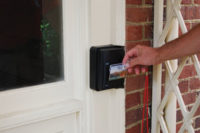Making a ‘Mesh’ of It

The above diagram describes one view of a wireless mesh network topology, where the end point devices are typically sensors, in this example, one-way devices (anything from security devices such as door/window contacts, or wireless pendants, to environmental monitors or automatic meter reading transmitters) and the network “mesh” infrastructure is provided by the repeater network. Chart courtesy of Inovonics
Security directors are high on mesh networks. The designers of the Dubai Towers in United Arab Emirates, the tallest structure in the world, went mesh, for example.
There are many definitions and details about mesh networks and wireless mesh nets. According to Mark Jarman of Inovonics, “Much of what I hear today is based around two ideas. Mesh networking is a way to route data, voice and instructions between nodes. And wireless mesh is a wireless cooperative communication infrastructure among a massive number of individual wireless transceivers.”
No matter the definition, Jarman and others believe mesh nets provide scalability, reliability and flexibility, whether wired or wireless.
When additional applications -- such as submetering, fire extinguisher monitoring and environmental sensors -- converge with security, the mesh network makes great sense. Scalability can also refer to the ability to extend the native range and the number of end devices of the wireless system beyond its initial design.
Mesh networks are designed to get the messages from end point to end point as reliably as possible. Since these devices can be at remote locations, the ability to verify that the end point is present and working properly is critical. If the wireless environment should, for some reason change, making communication between the end point and the network repeaters ineffective, the mesh network will “heal” by finding an alternate path from the specific end point to target destination, pointed out Jarman.
HOPPING FREQUENCIES
Mesh network systems based on frequency-hopping spread-spectrum radio technology are also inherently more reliable when compared to single channel technologies. Frequency hopping radio regulations allow for more frequent supervision and greater transmission power, which results in greater coverage area and overall more robust system performance.The best wireless systems are designed to provide maximum flexibility for the user. Once a wireless mesh network infrastructure is installed at a site, more applications can be added to it resulting in more cost effective deployments. Being able to amortize the cost of the mesh infrastructure over multiple applications presents the end user with a much better handle on managing the operating expenses of the facility. The ideal mesh network solution for life-safety or security systems will allow their advanced technology to work seamlessly with most any control panel, not just the ones offered by the maker of the mesh devices, according to Jarman.

Sophisticated security video software can capture, display and store images from mesh network cameras. Photo courtesy of Sam Systems
MESH PIONEERS
Viscount Systems of Burnaby, British Columbia, is a mesh pioneer. Just recently, a number of provincial government projects in Canada homed in on MESH, the firm’s flagship technology. Stephen Pineau, Viscount’s president and CEO, also told Security Magazine that mesh networks do well at organizations that have numerous remote facilities. One of the largest rail carriers in the U.S. is installing Viscount’s mesh technology, for maintenance and administration needs.There is mesh fever around the world. Korea-based Samsung Corp. recently deployed a Firetide mesh network at the construction site of the tallest free-standing structure in the world, the Burj Dubai (Dubai Tower), in United Arab Emirates. The newly installed Firetide network is being used for video surveillance, voice over IP and radio over IP applications at the worksite.
Drop in networking over ZigBee is one of Digi’s wireless strategy. According to Minnetonka, Minn.-based Digi’s Joel Young, there has been a natural migration to security after an initial application monitoring cellular phone towers. As compared to other wireless designs, ZigBee is targeted for low power, low cost and low transmission situations. It provides the ability to network devices or groups of devices (e.g., sensors, alarms, controllers) where no pre-deployed networking infrastructure exists or where access to an existing network is prohibited. Drop-in networking makes it possible to easily and cost-effectively poll, monitor, adjust and control systems that previously required laborious and expensive manual processes or extensive wiring.
Advances in software-based security video help propel mesh networks. One example is Sam Systems of Troy, Mich. A New Product Showcase winner at a Las Vegas ISC, the firm’s software significantly cuts bandwidth and storage, according to Joe Hannawa, the firm’s director of business development. The approach uses network video tunneling, adaptive video resolution as well as intelligent content analysis, added Chief Technology Officer Nick Brookins.
With seamless integration to Windows Media, the software allows security to distribute buffered video via public and private mesh networks as well as over other means of communications. Brookins eschewed such compressions as MJPEG and MPEG4 – “They were designed for entertainment,” said Brookins – for a unique feature set optimized for real-world surveillance situations.
Looking for a reprint of this article?
From high-res PDFs to custom plaques, order your copy today!





